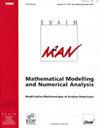混合形式非线性椭圆方程的模型自适应:解的存在性和数值策略
IF 1.9
3区 数学
Q2 Mathematics
Esaim-Mathematical Modelling and Numerical Analysis-Modelisation Mathematique et Analyse Numerique
Pub Date : 2022-02-04
DOI:10.1051/m2an/2022016
引用次数: 2
摘要
根据给定多孔介质的物理和几何特性,流体流动的行为可能会有所不同,从缓慢的达西模式到更复杂的布林克曼模式,甚至是高速的福希海默模式。主要的问题是确定在中间的什么地方一种制度比其他制度更合适。为了确定低速和高速区域,本文提出了一种自适应策略,该策略基于流体速度本身大小的阈值准则选择适当的连接速度和压力的本构律。理论和数值方面的考虑和研究,显示了所提出的方法的潜力。从分析的角度出发,在合理的本构律假设下,证明了该模型弱解的存在性。为此,我们使用变分方法识别具有潜在能量泛函最小值的解决方案。从数值的角度出发,我们提出了一种一维算法来跟踪低速区和高速区之间的过渡区。通过使用该算法进行数值实验,我们说明了我们的自适应模型在学术案例和小型相交裂缝网络中的一些有趣行为。本文章由计算机程序翻译,如有差异,请以英文原文为准。
Model adaptation for non-linear elliptic equations in mixed form: existence of solutions and numerical strategies
Depending on the physical and geometrical properties of a given porous medium, fluid flow can behave differently, going from a slow Darcian regime to more complicated Brinkman or even Forchheimer regimes for high velocity. The main problem is to determine where in the medium one regime is more adequate than others. In order to determine the low-speed and high-speed regions, this work proposes an adaptive strategy which is based on selecting the appropriate constitutive law linking velocity and pressure according to a threshold criterion on the magnitude of the fluid velocity itself. Both theoretical and numerical aspects are considered and investigated, showing the potentiality of the proposed approach. From the analytical viewpoint, we show existence of weak solutions to such model under reasonable hypotheses on the constitutive laws. To this end, we use a variational approach identifying solutions with minimizers of an underlying energy functional. From the numerical viewpoint, we propose a one-dimensional algorithm which tracks the transition zone between the low- and high-speed regions. By running numerical experiments using this algorithm, we illustrate some interesting behaviors of our adaptive model on academic cases and on small networks of intersecting fractures.
求助全文
通过发布文献求助,成功后即可免费获取论文全文。
去求助
来源期刊

CiteScore
2.70
自引率
5.30%
发文量
27
审稿时长
6-12 weeks
期刊介绍:
M2AN publishes original research papers of high scientific quality in two areas: Mathematical Modelling, and Numerical Analysis. Mathematical Modelling comprises the development and study of a mathematical formulation of a problem. Numerical Analysis comprises the formulation and study of a numerical approximation or solution approach to a mathematically formulated problem.
Papers should be of interest to researchers and practitioners that value both rigorous theoretical analysis and solid evidence of computational relevance.
 求助内容:
求助内容: 应助结果提醒方式:
应助结果提醒方式:


